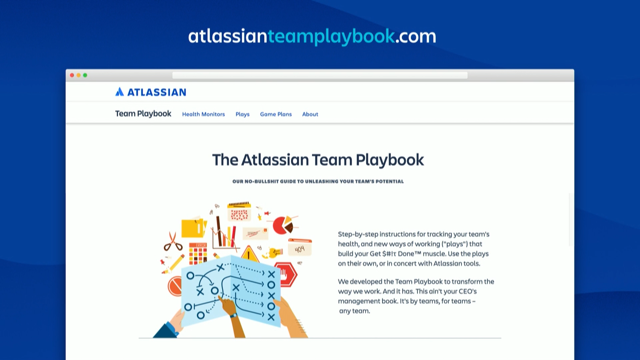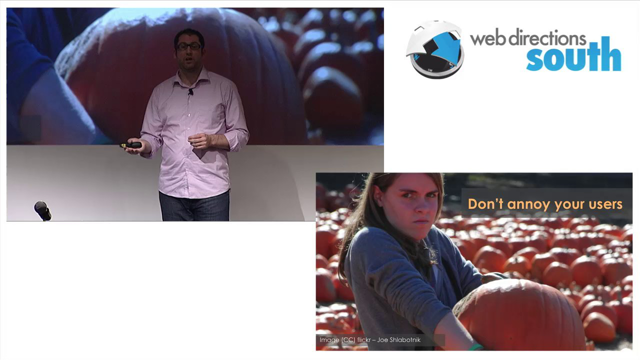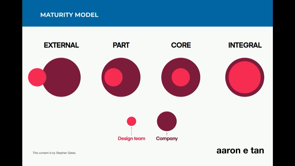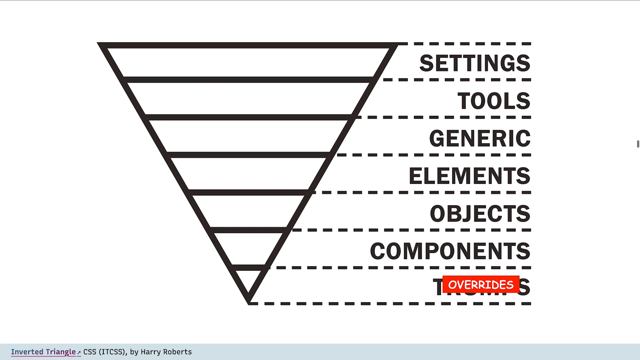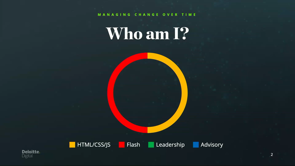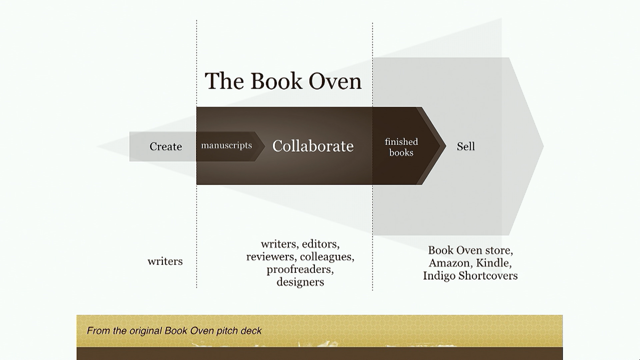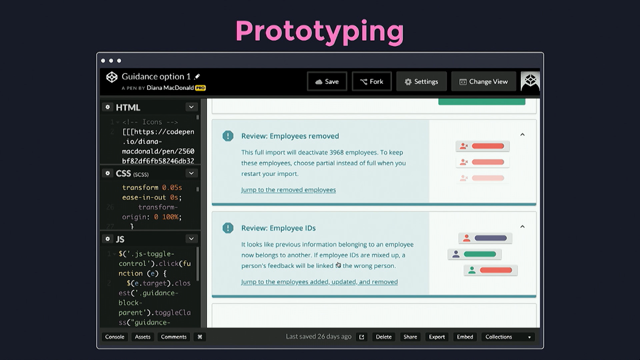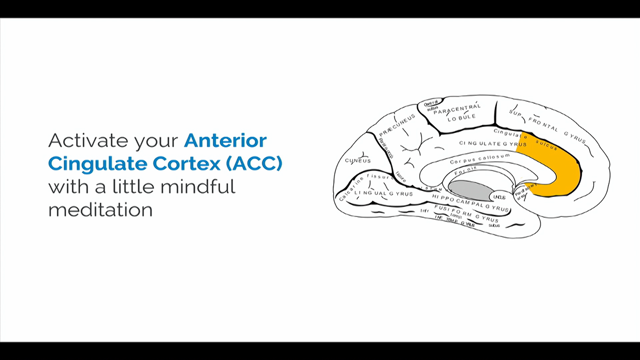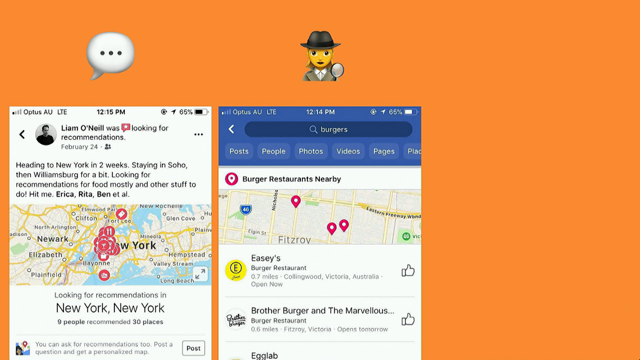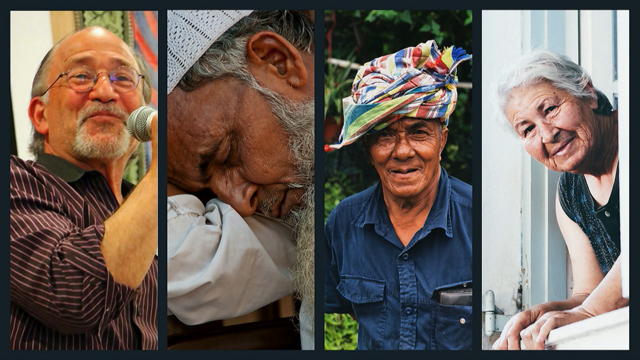
(bright electronic music) - Thank you so much.
First of all, yeah, I just want to say thanks to John Rosemond, the whole team, for having me here today, and congratulations to everyone who got to speak. I'm definitely inspired when I go back to Monday to make some change and fight the good fight. Yeah, but who am I? So my name is Chris Stonestreet, and my career spans over a 10-year period.
Spooky enough, Kate and I studied at the University of Canberra together, and I started off as a print designer, and quickly moved into sort of this digital design space, worked in my own business for a few years, dabbled with front end development and by no means to the output of work that I see developers doing today, and then around three to four years ago, I gravitated towards this human-centered design sort of ethos, which is maybe what I am today, but now I am, luckily, yeah, the User Experience Manager at nib Health Funds, and I have a really good team of five designers who are multi-talented, very collaborative, challenge the status quo, use data to change people's minds, et cetera, et cetera, and recently I've been really lucky enough to start our design ops team at nib, so we manage all the design systems, the tooling, the documentation of those processes as well, and every day I'm learning through interactions and talking to other designers in the community as well, so for all the UX designers in this room, and who is a UX designer? Hey, I brought some swag.
I brought some things.
So we have a corporate affairs office, and it is, who is over here? And it is full of these little footies.
Yeah, who else wants a little footy? Oh. (groans) Come and see me at the end, we've got plenty more. So you kinda have a little bit of a build up of my persona or proto-persona.
Who's an nib customer? I gotta talk to more of you.
It's nice on the sales pitch.
But I want to just make it clear, it's a bit awkward having a conversation with myself when I'm the only one onstage, but this is a conversation. It's stories from my past, things that I've witnessed, and things that I've done, too, and I'm also gonna share you some themes from when I've actually talked to other designers and leaders in design and that sort of stuff as well. So I want to say thanks to all those designers, developers, account managers, brand managers, product owners, all the titles who have helped me to shape this content today.
So how are we gonna break this thing down? This is kind of the contents that we'll look at, three areas.
I'm gonna tackle the individual designer first and then we'll bite off a bit more and we'll look at the medium organisations, and then we'll start to delve into the large enterprise. But I'm just gonna share this pretty funny blog post that I found, and I'm gonna read it verbatim here. It's from a guy named Mike Ditkoff, and he has this blog post on outsourcing sleep, and he says, "In an extraordinary move, "destined to be emulated "by forward-thinking business leaders everywhere, "I've just outsourced all my sleep to a guy named Namdev "in New Delhi.
"Yes, it's true.
"I no longer need to sleep.
"Namdev does it for me, and it's astounding "how much more productive I've been, "and as if my sleep breakthrough wasn't enough, "I've also outsourced all my exercise "to a guy named Sung Lee in Malaysia.
"God bless Sung Lee! "He's been on the Stairmaster for three hours now "and tomorrow he'll be working on our delts and our pecs. "Needless to say, I'm feeling totally buff right now, "and I was just about to have a big piece "of cherry cheesecake to celebrate my innovative, "time-saving enhancements "when I realised I've outsourced all my eating "to a woman named Min Yung in Taiwan.
"I'm down to 145.
"Hallelujah, my pants fit, but the only thing "I didn't outsource this week was this blog post "and a visit to my dentist," so if anyone out here is willing to do a root canal, get in contact with him.
But I find that this is sort of a comical approach of how we sort of talk about these things of outsourcing and we don't really understand the impact that it actually has on teams and individuals. But as we go down this path of this conversation, I just want to clarify a little bit what I'm talking about when I say outsource design.
I'm not referring to an individual designer who's just doing sort of pixel-pushing or putting data into some spreadsheet for you. I'm not talking about that at all.
I'm talking about outsourcing design in terms of substantial aspects of work to another designer, such as user research, testing, prototyping, and full fledged prototypes of high fidelity design or interaction design.
So hope we're kind of on the same page.
I hope you can see this little animation, but I've seen a lot of these repeat patterns happen, and it's whether an organisation or an agency is going out to seek design, or when a designer is supplying design services to that organisation or agency, and I call it a sheep in wolf's clothing.
And I've recently come to notice designers selling UX through UI, but not actually understanding what the discipline means.
They're merely visual designers confusing the UX process, and hand on heart, that's your heart there, I was confused, too.
I had a title where I was like, "Yeah, I'm a UI/UX designer," and then I changed it to a digital designer because I was selling myself but not actually understanding that role as well. So what are my recommendations? That's an observation.
What's my recommendations? You've got to balance your team.
You've got to contract specialist designers to balance that team out, and there is no unicorn designer. We've got to stop looking for these people, and as a manager, now that I hire as well, I'm starting to realise they don't exist, and there's no rock that I can find them underneath. When you contract a specialist in, those individuals help to grow your team, they definitely get to upskill.
Forget about sending them off to a certain four-month course to learn UX. Get a, that's a talk for another day, get a designer or a contractor in and upskill the team by actually doing the work with them, that pair design. It allows the team, when that work is sort of done, to have artefacts that they can use in the future when moving forward as well.
The last one is if you're looking to work with a design firm or contract a freelance designer, just frigging meet them.
Go past that account director or that recruiter and actually try and sit down and talk to that designer, understand what their definition of empathy is, understand what they think the design process is in terms of how they're gonna solve a problem for you. After all, building great products doesn't happen in isolation, and you need the right people to be able to work as a team, and when I've tried this in the past as well, I've seen exceptional teams grow from this, when you actually start to have that empathy for the designer doing the work.
This is the next topic I'll talk about, which I call the Kool-Aid effect, and I've started to see a lot of organisations and agencies latch on to this sort of human-centered design terminology as a sales mechanism.
And they don't actually fully provide the services required to solve that business problem or those customer needs, and I've sat in a lot of presentations and a lot of workshops, where we've littered the walls with Post-it notes, we've had value effort matrix on the wall and all these other sort of diagrams, and we've sort of said, "Yeah, let's have a high-five. "We think we know how we're gonna solve this problem. "This is great," and then the adrenalin subsides, that workshop high kind of wears off, and the next artefact that we see is a high fidelity visual design ready to be built or it's gonna be going into production, and the problem here is the user-centered design has been half-heartedly incorporated into that part of the process, and stakeholders have drunk the Kool-Aid, and they've said, "Yeah, this is what UX does. "They give me what I want." And a lot of frigging time, money, and effort has been spent, and it doesn't even tell the story of what the user wants or what the user actually needs, and the biggest problem was no users were involved in the process at all.
All we did was role-play assumptions.
We talked about our own behaviours, obviously, with our bias, and talked about our own experiences, but it's okay, we had a persona stuck on the wall. It's fine, and we said to each other, "Yeah, that's what our user wants," and then as time goes by, you start to question, okay. Yes, sorry, and after time goes by, you start to sort of question, okay, when are we gonna get the user, and I'll always hear the same response of, "It's a lot of work to get that in front of our users. "There's not enough time.
"We don't have the budget to do this." And don't be fooled, there's a lot that you can do as individuals if you see this happening.
The first thing is actually call it out.
Question why are we doing this at all if we don't have money or resources to talk to our users.
Challenge why there's no money in the budget at all, and if you work for an organisation that says they're customer-centric and user-focused and first and all that sort of stuff, question why there is no budget in our money if that's our ethos.
Identify the steps that are being skipped and document these, and make sure you package them up in a way that you can give them to an executive or a stakeholder.
Highlight the best industry practises of why you need to do these certain things. If the project's too far gone, that's okay. It's not always lost.
Just report that.
Make sure you call that part out.
Compile the information and give to those stakeholders, and then start to propose how you can actually put some user testing in place after that first release.
The last one is just start advocating to do things the right way.
Scream it from the rooftops, start to really piss people off and push users to come into the equation.
I'm gonna share a quick story with you here. Around many, many, many moons ago, when I was working in an agency and we had to contract another agency in to do some work, we sat down and we were writing briefs and requirements and things, and they were writing, documenting stuff down, and they would pitch back to us to say, "Hey, we think this is what we're doing." I was like, "Yep, that sounds about right." Then they would go off and it went quiet.
We didn't receive anything back, we couldn't see anything, we kept pushing and challenging them, "Where is the work? "We need to check in," and what we learned was we got communication wrong, and we actually found out that that product was about to, well that web application was about to be released, and in the requirements document, none of what they had designed and built was actually covered.
So we got the communication wrong.
The recommendation from this is to say, to call it out again and make sure that you define who will be presenting this communication material back.
Roles and responsibilities are also something that's quite difficult to define when there's a grey area between UX and UI, if you've got two UXs working on a piece of work together, one's from internal and one's from external.
Start to do some roles and responsibilities as well of who will be doing what and when, and make sure that the team is integrated as well. Outsourcing to vendors doesn't give them an initiative to change company methods, but partnerships do. For example, a lawn care maintenance guy would never recommend you to put down artificial turf. It doesn't make any business sense.
And this last part, I wasn't sure if I was going to go into, because I don't have first-hand experience with the large enterprise companies, but it's definitely an area where I have an interest in how that state of play is going to happen. And I've spoken to a few leaders on Slack and a couple of phone calls and appear in talks and things like that to start to dip my toe into this area, and a few people have pushed me towards this Design In Tech report from 2017, which shows that 70 design firms were acquired since 2004, with 50% of those happening between the years of 2015 and 2016.
So there's a race for these large enterprise companies to start devising more digital and human-centered design strategies, they're trying to scale quite quickly, they're branching out into new commerce areas, they're looking at mobile and wearable platforms, they're looking into AI and VR as well, and they fall into three categories, which I'll go over quite quickly here.
Organisations that just buy, so we obviously know the Adaptive Path and Capital One acquisition that happened, and when that was being acquired, Adaptive Path was also trying to set up a team in the UK. The other one is build, where large organisations such as Johnson & Johnson invested a lot of money and effort into internal design teams, and actually coming up with new titles such as Chief Design Officer, which is a talk for another day.
Titles are so confusing.
And then the last one is a combination of buy and build, so IBM is probably the best one to talk about, that they've spent a hundred million dollars in global investment in a boost to bolster their design business as well and their service offerings.
So in 2016, IBM purchased three digital agencies to start what they call the IBM iX or Interactive Experience teams, and I think there's more acquisitions that have happened where IBM has brought out Bluewolf which is a part of Salesforce as well.
They also went on a recruitment rampage and hired thousands of designers to bolster out these 10 new interaction labs in London, Beijing, and I think there's even one in Melbourne as well, so they going on quite a large recruitment drive. But as I was talking to some of these people around, how does outsourcing work in large enterprise companies, there's a couple of themes that came out of this. If the parent company only focuses on a particular sector, designers may find that the projects that they're working on, more restricted.
This is great for those who want to specialise in that particular sector, but then on the flip side as well, we get to see designers diversify, so ones that were once sort of shoehorned into a certain area, they're now getting exposed to a lot more problem spaces that they didn't get to see in the past, and that's okay for ones who like to become a bit more of a generalist, but design companies can tend to lose their culture once they're acquired as well, which is a risk to what actually once made them unique.
They lose their identity that may have been once appealing to a person when trying to apply or to contract to that organisation.
From a business side, there's a bit of less pressure to pitch, I found, when talking to others.
You don't really need to pitch to win the new business. It's always gonna be there.
You've got a large enterprise company behind you, paying and driving for these initiatives, so all that hard work has been taken away to acquire new business.
So you've taken a lot of knowledge onboard in this talk, and I just want to leave you with some quick takeaways, so when you go back to work on Monday, and if you're having to contract out a designer, or you're a designer who's about to go into a new partnership with an organisation or an agency, here's some stuff that you can take away with you. Make sure that the team is integrated.
Make sure that they feel like they're one of yours and not a separate team member at a different company or a different agency.
Treat them, like I said, is one of your own. Onboarding is really, really important.
As humans, we need to be guided through the onboarding process, so make your design process, your documentation, your tooling available. Make sure it's perfectly clear so that they can pick it up and read it and understand that.
Talk about how the design process works in your organisation as well, and the quality of work and that calibre that you expect.
If you're fortunate enough to have design ops teams, or hell, even just a design system, give them access to that as well and let them understand how that works and how that can speed up their workflow.
Make sure you're available.
Not just yourself but also to the wider team as well. When you contract people in, they're gonna have questions. It's only natural.
They're gonna have doubt in how things work, and if you're not available to talk to them when they need you, they'll start to lose interest and detach themselves, but one thing around availability that I've learned is the power of pair design. It's a real thing, Google it.
But it's where you can, basically, if you have two different designers, individuals working on a piece of work, and one is an external and one is an internal, get them together.
And continuous delivery is really, really, really important as well, so don't get the impression that once the work is outsourced, that it's done.
It's not the right attitude to have.
You do need to continually collaborate as well. You obviously understand in your own business or organisation, the context of what goes behind the scenes, especially if you're in the ATO, you understand that complex landscape, and every time you have to bring a new designer in, it's gonna be very difficult to try and explain that to them, so think about continuous delivery. It starts to ensure that the work is flawless, and it also maintains a high morale for the team. The team that's current, that's embedded in the organisation, don't get that revolving door effect, where they're just another designer coming in and now they're gone.
So that's my talk or my conversation.
Like I said, it's a bit awkward when you're up here by yourself, trying to have a conversation with everyone, but I do want to talk more about this topic of outsourcing design because I have seen impacts that it has on the team, both good and the negative, and I want to understand your perspective, so if you're an individual designer who's contracting for an organisation or you're inside of an organisation, I want to talk to you, so definitely hit me up at my email address and I'm also on Twitter as well, and I'll shout the bees. I'll come and see you and shout you a bee for it. And that's me, thanks so much.
(audience applauding) (bright electronic music)

